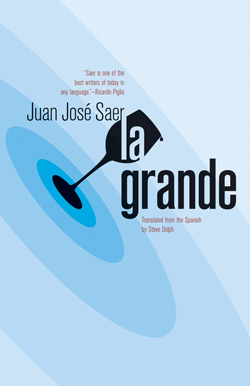La Grande
by Juan José Saer, translated by Steve Dolph
reviewed by Gabriel García Ochoa
Juan José Saer’s last novel, La Grande, was published in Spanish shortly after the author’s death in 2005 and translated into English this year by Steve Dolph. Like most of Saer’s works, La Grande takes place in Santa Fe, the province of Argentina where the author lived until the late ’60s.
What is La Grande about? Everything and nothing, or as Nula, one of the two main characters in the book, puts it: “The affinity between wine, sex, poetry, and philosophy—common ground of the melancholics.” Nula used to be a philosophy student, but now he sells wine to support his family. He is in his late twenties and, in spite of being a womanizer, is madly in love with his beautiful wife Diana. He travels around Santa Fe selling wine to his customers and in so doing introduces us to the troupe of characters who populate the novel, many of them old acquaintances for those familiar with Saer’s works: Tomatis, the Rosembergs, Escalante, Pichón Garay.
First and foremost among Nula’s customers is the other main character in the book, Gutiérrez, a fifty-eight-year-old screenwriter who has spent the last three decades in Europe. Mysteriously, he has come back to Santa Fe, now a wealthy man trying to reconcile his present with the lives he might have led: what would have happened if he had stayed in Argentina? Could he have survived the darkest years of the Guerra Sucia, the Argentine Dirty War? How different would his life have been? Was leaving the right choice?
These “what ifs” are a common topic in Saer’s works, and it is difficult not to spot parallels between Gutiérrez’s story and Saer’s own. Along with Ricardo Piglia, Rodolfo Walsh, Manuel Puig, César Aira, and Sergio Chejfec, Saer was one of the most important writers of Argentina’s post-Borges generation, but most of his oeuvre was penned abroad. Like Gutiérrez, he wrote screenplays and lived in self-imposed exile in Europe for over thirty years. But unlike his protagonist, Saer never resettled in Argentina, though he frequently visited.
The plot of La Grande takes place over seven days. À la Mrs. Dalloway, the first five chapters of the book are geared towards a Sunday barbecue in the sixth, when the majority of the characters converge. One chapter is dedicated to each day, the last only one poignant sentence long: “With the rain came the fall, and with the fall, the time of the wine.”
The most striking element of Saer’s writing is his prose, at once dynamic and poetic. He is fond of long, slithering sentences that can easily take a paragraph or a page. The winding syntax that is so characteristic of Saer’s style is not unusual in Spanish and French, but in English it has fallen out of fashion. In translating La Grande, Dolph, who has translated two other works by Saer, The Sixty-Five Years of Washington and Scars, had to make a choice between remaining loyal to Saer’s style or making the text more palatable for a mainstream contemporary English readership. That is to say, he had to decide whether or not to break those long sentences down into smaller, more digestible ones. Dolph chose wisely: he presents a text that is clear and accessible, a beautiful rendering of the original that is true to Saer’s style but does not feel cryptic at any point.
The plot of Saer’s novel is strangely uneventful, a series of tableaux in which nothing really happens—except life: a Sunday barbecue, an anticlimactic love affair, several conversations. As in previous works, Saer uses the poetic elements of his prose to tease the ineffable from the mundane. “He left his house and had to cross the whole universe to get to the corner, and now he knows the effort required to reach the corner, and the significance of the immediate.” If the magical realists showed that magic can be ordinary, Saer demonstrates that the ordinary can be magical too.
The final chapter of La Grande was not originally meant to be one sentence long. Dolph explains in his afterword how the sentence that now ends the book was intended to be the opening line of the novel’s last chapter before the composition of the book was cut short by the author’s death. But even if it doesn’t have the ending Saer planned for it, La Grande does attain completion, and it is brilliant. It is not a fragmented manuscript, but a highly polished, albeit unfinished, version of what was clearly very close to the book’s final form.
Published on November 14, 2014

